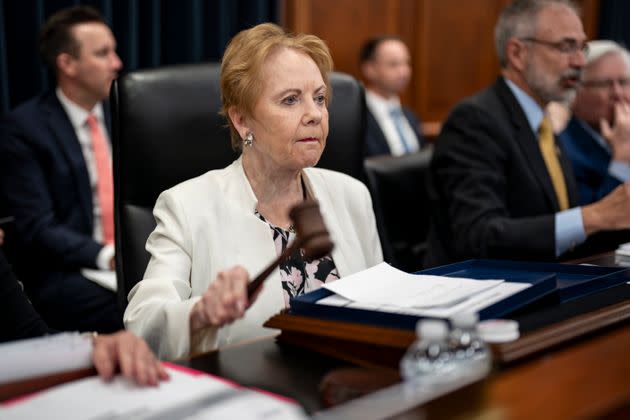House Republicans Take First Steps Toward A Possible Government Shutdown In October
Two weeks after there was bipartisan relief that an economically disastrous government debt default had been avoided, there’s rising concern on Capitol Hill about whether the government can stay open past September.
A government shutdown would shutter many parts of the government deemed nonessential, but keep intact some vital functions, like defense.
Politically, it would be a wild card heading into the 2024 elections. In the past, presidents have usually won such standoffs, often because they are seen as standing up to Congress and have the bigger bully pulpit in the form of the White House.
The House appropriations committee, the panel that decides which agency or program gets how much in each year’s so-called discretionary spending budget, met early Friday and may have set the stage for a later blowup by approving spending numbers that Democrats say renege on promises made during the debt limit talks.
“If we disregard the law of the land, we all but guarantee a shutdown in October,” Rep. Rosa DeLauro (D-Conn.), the top Democrat on the appropriations committee, told the committee in an uncommonly sharp rebuke for a panel considered one of the most bipartisan in Congress.
If we disregard the law of the land, we all but guarantee a shutdown in October.Rep. Rosa DeLauro (D-Conn.)
Bills funding the government must be passed by Sept. 30, or the government goes dark. The debt limit was supposed to answer one big question: how much to spend next year.
In the debt deal, the two sides agreed on general numbers that would serve as a limit on discretionary spending ― $1.59 trillion for next year, with $886.3 billion going to defense and $703.7 billion for non-defense.
To Democrats’ chagrin, Republican appropriators Thursday instead chose a lower overall number ― $1.47 trillion, the number used for 2022 discretionary ― as the spending target.
To compound things, they stuck with the defense number in the debt limit deal, meaning the total government funding pie would be smaller than what Democrats thought they’d agreed to only weeks ago ― and the slice of that pie available for agencies and programs outside of the military would be even smaller.
Because appropriators have historically treated the cap as the floor too, Democrats say they’ve been double-crossed.
“What the hell is the point of making a deal if you’re then told, ‘Oh, that was the ceiling on the deal, what we really want is a lot less’? Why? Because 20 people have us captive,” Rep. Steny Hoyer (D-Md.) said at a committee meeting Wednesday night.
“It’s wrong,” Hoyer said. “We ought not to be doing it that way.”
What the hell is the point of making a deal if you’re then told, ‘Oh, that was the ceiling on the deal, what we really want is a lot less’?Rep. Steny Hoyer (D-Md.)
The 20 people Hoyer referred to are the hard-line House Republicans who pressured House Speaker Kevin McCarthy (R-Calif.) to go back to the 2022 numbers as a price for them allowing bills onto the House floor after a standoff last week.
Because of the GOP’s slim majority in the House, McCarthy can only lose four Republicans and still pass bills with no Democratic votes ― and under the numbers from the appropriations committee, the cuts to non-military programs would be so deep, it’s unlikely they could pass the House on a party-line basis.
At the same time, within the House GOP conference, there’s appetite for bigger cuts. The conservative Republican Study Committee, the biggest intraparty group in the House GOP, released its own budget blueprint Wednesday. That document calls for only $522 billion in non-defense spending, below even the non-defense cap approved in the appropriations committee.
And unlike with the debt limit episode, Democrats are unlikely to try to bail Republicans out of the jam, potentially leaving the House GOP in a dilemma before Sept. 30: accept funding figures sent over from the Democratic-held Senate, accept a temporary stopgap bill until things get resolved, or let the government shut down.
While accepting the Senate’s proposed funding plan would keep the lights on, it would mean House members’ ideas on how money should be spent, boosting some programs and dialing back others, would likely be ignored.
“I hope that it isn’t 99% of what the Senate sends over that we end up having to vote on,” Rep. Pete Aguilar (D-Calif.) said. “I hope we’re equal partners in this. I’m not optimistic.”

House appropriations committee Chair Kay Granger (R-Texas) said the spending limits approved by her panel Thursday reflect House GOP priorities.
House appropriations Chair Kay Granger (R-Texas) said the numbers approved Thursday simply reflect Republicans’ desire to refocus spending on defense, veterans and homeland security.
“The allocations before us reflect the change members on my side of the aisle want to see by returning spending to responsible levels,” she said.
On Monday, McCarthy downplayed the potential for a shutdown, even as the agreement with hard-liners he touted appeared to boost the odds of one.
“You always come with the negative. You’ve got to be more positive in life,” he said, when asked if he had traded avoiding default for a likely shutdown.
“We’re continuing to work forward,” he said. “We’re having good successes here. I keep you in my prayers.”
With the fiscal year ending Sept. 30, and the House out for six weeks in August and September, there are only 28 working days for the House left to see if McCarthy’s optimism is justified.

 Yahoo Finance
Yahoo Finance 